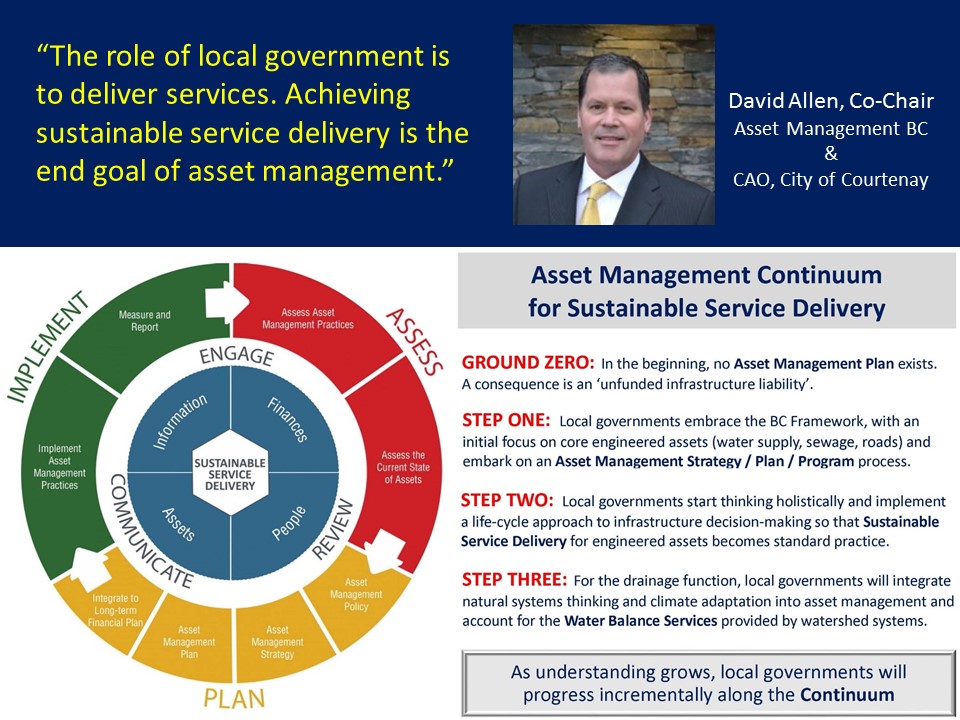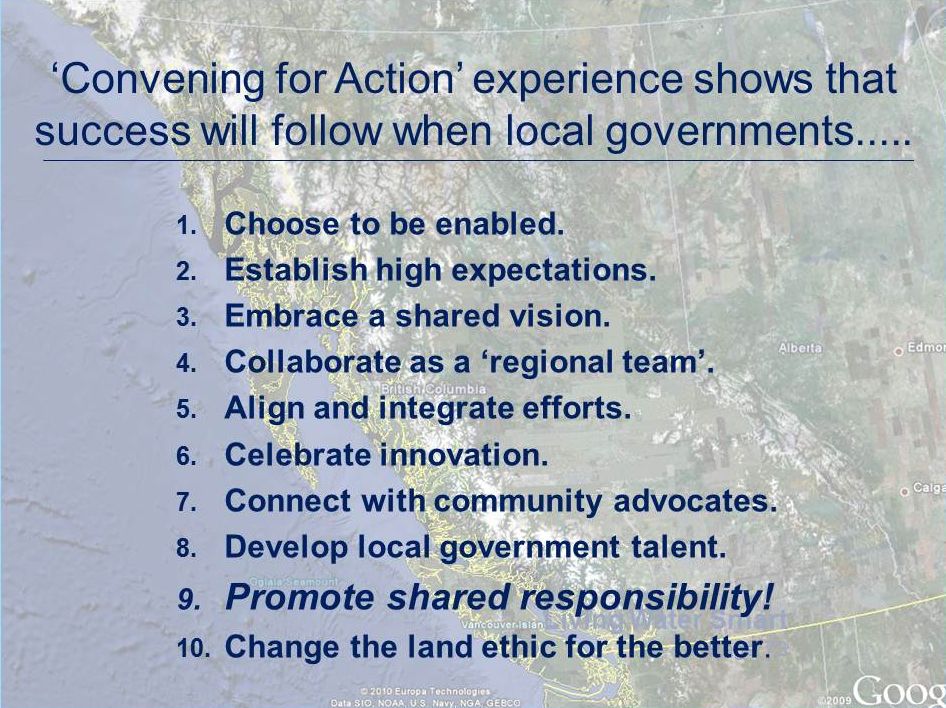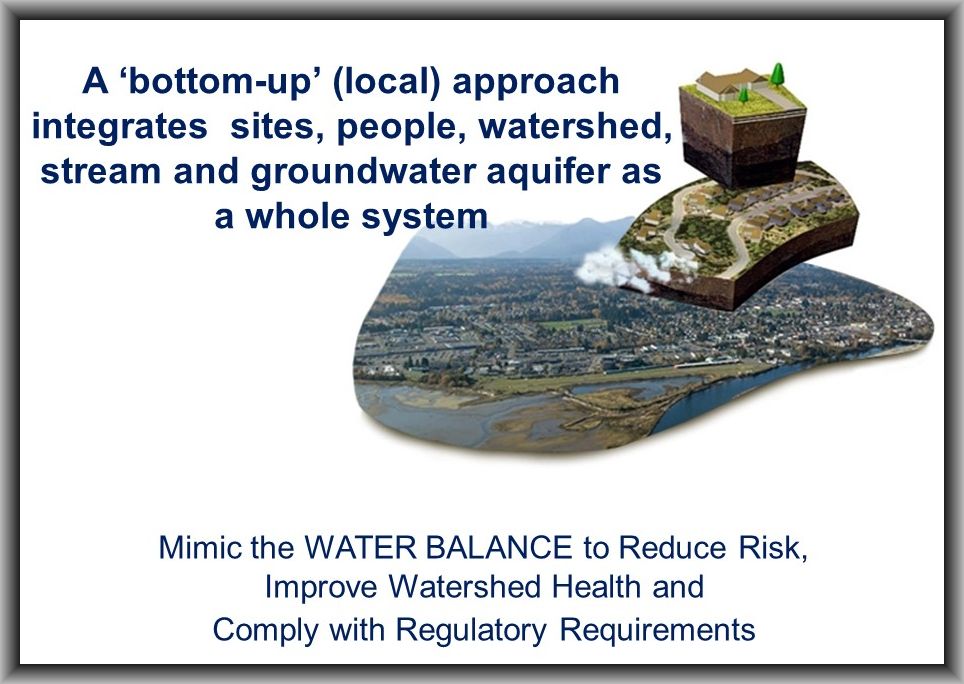Water Sustainability: "Convening for Action experience shows that success will follow when local governments embrace 10 guiding principles," stated Kim Stephens during a lecture delivered in Parksville (Nov 2016)
Since 2001 Todd Pugh has served as the Executive Director of CivicInfo BC, a not-for-profit information service for BC local governments. In 2007, he joined Capilano’s Local Government Administration Certificate program as a sessional instructor. The program has four core courses: Administration, Services, Finance, and Law. Todd is responsible for three of these courses when they are held on Vancouver Island.
In Fall 2016, Todd Pugh taught the course titled Local Government Services in BC, held in Parksville on Vancouver Island. He invited Kim Stephens, Executive Director of the Partnership for Water Sustainability in BC, to deliver a guest lecture that would inform participants about future directions in the water service sector from the local government perspective.
What Happens on the Land Matters
“For years, I have been teaching in Capilano University’s local government administration program,” stated Todd Pugh. “The ‘students’ are all municipal professionals, and there are 30 people in the class, representing some 17 local governments.”
 “Water sustainability is a huge issue in a lot of the communities where these individuals work. And it occurred to me that Kim Stephens may know a thing or two – or, more likely, a million things or two – about that particular subject. So I asked him whether he would be interested and would it be possible for him come out to my class in Parksville to deliver a talk and presentation to my class. Kim accepted my invitation without hesitation.”
“Water sustainability is a huge issue in a lot of the communities where these individuals work. And it occurred to me that Kim Stephens may know a thing or two – or, more likely, a million things or two – about that particular subject. So I asked him whether he would be interested and would it be possible for him come out to my class in Parksville to deliver a talk and presentation to my class. Kim accepted my invitation without hesitation.”
“Kim was able to communicate concepts in a way that made sense to the class. They understood him perfectly. It is such a mix of people – there were some who would have liked to hear more about the science behind what he presented, and for others it was more science than they’ve experienced since elementary school. So on the whole, I think he hit the right mix.”
Restore the Urban Water Balance!
“Todd’s invitation provided me with a focus group opportunity,” noted Kim Stephens. “While it was a local government audience, it was not my usual audience of engineers,  planners and environmental protection officers. The class represented a diversity of roles within a local government – including functions such as municipal clerk, recreation coordinator, bylaw enforcement, transportation and civic properties.”
planners and environmental protection officers. The class represented a diversity of roles within a local government – including functions such as municipal clerk, recreation coordinator, bylaw enforcement, transportation and civic properties.”
“In other words, water resource management would not normally be top of mind for many of these individuals.”
Shared Responsibility
“Because one of my themes is the need for everyone in local government to embrace shared responsibility, I was curious as to what would catch their attention and/or stick with them. So I knew I had to introduce and explain concepts about water resiliency in a way that made sense to everyone in the room.”
“Beyond the Guidebook 2010 synthesized a set of ten guiding principles that provide a framework for a successful local government ‘convening for action’ process. Everyone has a role, and everyone can act – all levels of government, developers, regulators, bureaucrats, consultants, planners, engineers.”
“It is important that all the players understand WHY there is a need to change and to do business difference. Hence, a core concept is the legacy of past community planning and infrastructure service practices. Simply put, the problem is that the natural water balance of watersheds is out of balance. This means that communities must implement practices that restore the hydrologic integrity of watersheds.”
Mimic the Water Balance
“To achieve hydrologic integrity, it is necessary to mimic the water balance. This would reduce risk and improve watershed health. Achieving this outcome requires a bottom-up, or local, approach that would integrate sites, people, watershed, stream and groundwater aquifer as a whole system.”
“Whole systems thinking is the exception, not common practice. To promote a change in thinking, we have are re-framing watershed management in terms of infrastructure management. Watershed are infrastructure assets. They provide services. Protect and manage them as assets.”
Sustainable Watershed Systems,
through Asset Management
“The role of local government is to provide services. So I introduced the class to the vision for Sustainable Service Delivery; and explained why we are applying it watersheds as well as traditional engineered infrastructure, as well as how Sustainable Watershed Systems would be achieved through asset management.”
“In particular, I emphasized.that the compliance requirements for provincial grant programs provide the financial incentive for integration of ‘watershed systems thinking’ into asset management.”
Sustainable Watershed Systems, through Asset Management describes a “whole system-water balance” approach to community development and infrastructure servicing. Branding commenced with release of Beyond the Guidebook 2015 in November 2015.
 To Learn More:
To Learn More:
Download What Happens on the Land Matters: Restore the Water Balance in Urban Areas! to view a PDF copy of the complete PowerPoint presentation by Kim Stephens in Parksville on November 18, 2016.
Beyond the Guidebook 2015: Moving Towards “Sustainable Watershed Systems, through Asset Management is the third in a series of guidance documents released over the past decade. The series builds on Stormwater Planning: A Guidebook for British Columbia, released in 2002.
Sustainable Watershed Systems: Primer on Application of Ecosystem-based Understanding in the Georgia Basin is written in a magazine-style to help multiple audiences – whether elected, administrative, technical or stewardship – ask the right questions and ensure that “science-based understanding” is applied properly and effectively to implement land development practices that restore the water balance (hydrologic integrity) of watersheds.





